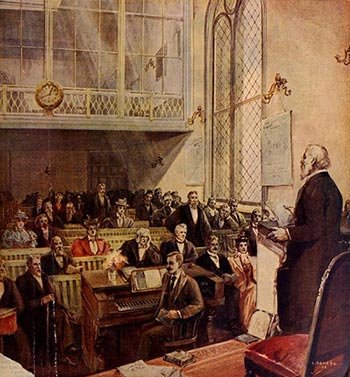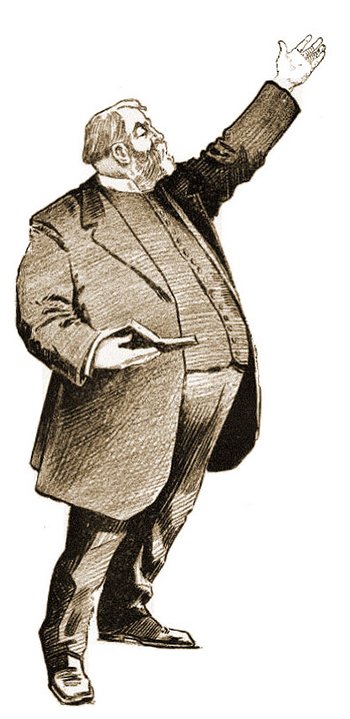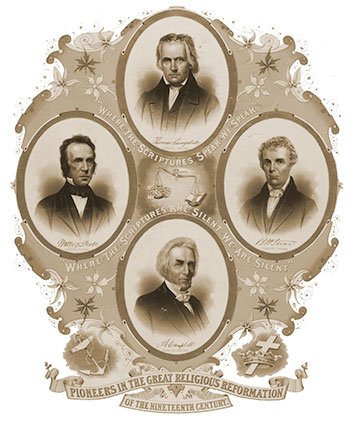19th Century Revival Heroes

Fulton Street Prayer Meeting
This amazing century saw no less than three worldwide revivals and one evangelistic and missionary resurgence which arguably brought more converts into the Kingdom of God than all the major revivals before it.
It began with the 2nd Great Awakening which was already in full swing by 1800. Next was the revival associated with Charles Finney in the 1830’s and 40’s. Then came the mid-century Prayer Revival in 1857-1860, followed by the greatest ever evangelistic and missionary movement which ushered in the 20th century!
Needless to say the century was packed with some of history’s greatest Revival Heroes, beginning with James McGready, Barton Stone, Peter Cartwright and Lorenzo Dow. Charles Finney dominated 1830-1840’s, Jeremiah Lanphier initiated the Prayer Revival and Dwight. L. Moody the 1880’s evangelistic awakening.
But there were many more! We have listed many of them here.
19th Century Revival Heroes in Britain
Prompted by a Lorenzo Dow UK visit Hugh Bourne and William Clowes were used in the 1807 the Mow Cop Revival.
In the 1830’s John Elias, Christmas Evans and William Williams stormed Wales with their powerful revivalistic preaching.
In the 1830’s. Robert Aitkin and William Haslam held highly successful missions with periodic revival. J. N. Darby and Anthony Norris Groves began the Plymouth Brethren restoring the doctrines of the church and the return of Christ. George Müller and Henry Craik followed suit beginning a church in Bristol which soon met in 4 congregations, numbering 1200 believers. Müller also pioneered orphanage work, evangelism, Bible and tract distribution and missionary work across the globe.
In the 1830’s John and Horatius Bonar, Thomas Chalmers, Robert Murray McCheyne, W. H. Burns and his son, William Chalmers Burns pioneered revival ministries in Scotland.
In 1832 Edward Irving, who strongly believed in the restoration of spiritual gifts and apostolic ministries to the church, began the Catholic Apostolic Church after pastoring the National Scotch Church of Regent Square, London.
In the 1840’s the Irish-American James Caughey, visited England and earned the title ‘King of Revivalist Preachers.’ It was during this time, when preaching at Nottingham, that William Booth was converted under his ministry. He recorded over 20,000 converts during this time.
In 1857-1859 England and Scotland were blessed with the ministry of a number of remarkable evangelists. Included among them were, Reginald Radcliffe, Brownlow North, Richard Weaver, Robert Aitken, William Haslam, H. M. Grant, and Duncan Matheson.
David Morgan saw remarkable conversions of souls in 1858/59.
In 1859 James McQuilkin and his prayer labourers held a meeting for revival in the First Presbyterian Church in Ahoghill,
County Antrim, Ulster, with three thousand people outside in the rain.
The same year the Rev. H. Grattan Guinness preached to at least 15,000 people in the open-air at Belfast and David Morgan visited the counties, towns and villages preaching in the power of the Holy Spirit, reaping a mighty harvest of souls.
67 year old Charles Finney was used to bring revival to Bolton in 1859 and became the spearhead of a revival movement among the Congregationalists and Methodists.
In 1859 William Booth, with Catherine, experienced a time of revival when he pastored a New Connexion (Methodist) Church. They launched the Christian Mission in 1865, later becoming the Salvation Army. They experienced powerful moves of the Spirit for many years across the UK.
In 1859 Dr. and Mrs. Walter C. Palmer visited Newcastle-on-Tyne, Northumberland, which become the scene of a religious awakening, followed Sunderland and Gateshead, and Cardiff, Wales where ‘a remarkable work of the Spirit’ was acknowledged.
Charles Haddon Spurgeon preached to capacity crowds each week in 1861, filling the largest halls in London. Metropolitan Tabernacle was opened seating 3,600; often over 5,000 attended
1861 Another American, E. Payson Hammond, visited Liverpool, UK in 1861, addressing large gatherings with hundreds of inquirers. The same year Reginald Radcliffe began Sunday evening meetings in the Concert Hall which was overflowing. He saw ‘an extraordinary work of the Holy Spirit,’ with converts in the hundreds.
Dr. and Mrs. Walter Palmer, experienced stirring times in Cardiff, in 1862, affecting public morals, bringing hundreds to prayer meetings.
In 1862 Richard Weaver filled the largest building in South Wales, the Music Hall, with 4000 people and ‘half the people could not get in.’ In 1863 he visited Cardiff and crowds of 3000 attended, 500 professing faith in Christ.
D. L. Moody and Ira Sankey enjoyed their greatest success in the 1860’s, Hudson Taylor began the China Inland Mission, Gawin Kirkham started the Open Air Mission, Lord Shaftsbury championed for the cause of the young, the poor and the oppressed, Barnardo founded his famous orphanages, David Livingstone and Mary Slessor propagated missionary work in Africa.
James Haldane devoted the summer months of 1800 to evangelism in the Lowlands of Scotland. In the ancient town of Ayr, he preached in the open air to crowds of up to five thousand.
19th Century Revival Heroes in America
1800 James McGready and Barton Stone witnessed an astounding revival at Kentucky with much trembling, shaking, tears, shouting and fainting. The next year Stone was invited to minister at the Cambridge meeting house in Bourbon County where a second visit attracted 20,000 people to a 6-day camp-meeting, which witnessed astounding revival scenes.
Peter Cartwright converted at Kentucky meetings, joined the Methodist Episcopal Church, started preaching in 1802 and became an itinerant revivalist for 35 years.
Lorenzo Dow preached in the Court-house at Knoxville, Tennessee, 1805, when about one hundred and fifty of his hearers were exercised with “the jerks.”
Between 1812-44 Asahel Nettleton conducted a revival ministry and from 1820-70 Charles Finney saw revivals scenes with masses of converts. From 1816-1856 Daniel Baker, also exercised a widespread and effective ministry.
On September 23, 1857, Jeremiah Lanphier started a weekly, businessmen’s prayer meeting in Fulton Street Church, Manhattan – 6 people met. The following week twenty men came, and the next week forty men turned out. The Prayer Revival, which reaped a million souls in US, had begun.
In the following years Humphrey Rowland Jones, A. B. Earle and Jacob Knapp conducted effective revival meetings.
1880-81 winter, Francis E. Clark, pastor of Williston Congregational Church, in Portland, Maine, oversaw a time of revival.
19th Century Revival Heroes outside of US and UK
Though there were a number of revivals in the 1830’s in various parts of the world, particularly in Scandinavia, central South Africa, the Pacific Islands, India, Malabar, and Ceylon, also, in 1859-60, in Jamaica, Natal and South Africa, Ukraine, the names of the revivalists God used are unknown.
Hans Nielsen Hauge was used in the Norwegian revival of 1796
From 1810 Robert Haldane experienced evangelical awakenings in Switzerland, France and Germany.
Titus Coan saw an astounding revival in Hilo, Hawaii in 1837.
Between 1838-1852 Johann Christoph Blumhardt experienced flocks of people coming to God in Möttlingen, Germany, after two women experienced deliverance from evils spirits. 1852. Blumhardt and his wife moved to Bad Boll, in the district of Göppingen in Baden-Württemberg, Germany, where thousands flocked to find spiritual restoration and renewal.
Revival came to Sweden in 1844 under Lars Levi Laestadius and 1859 in neighbouring Uppsala, Sweden, Paul Petter Waldenström was converted in 1858 and soon became the leader of a revival movement.
In 1860, also in Scandinavia, the Danish island of Bornholm, far to the east in the Baltic Sea experienced a religious awakening led by P. C. Trandberg. In 1865 Vilhelm Beck and Johannes Clausen engaged in a wider ministry of evangelism and revival which spread to the city of Copenhagen and through Zealand, Lolland and Jutland.
In the 1860’s, Lord Radstock followed by, Friedrick Wilhelm Baedeker had enormous evangelistic success in Russia.
1876-77 another revival of evangelical Christianity occurred in Sweden under August Skogsbergh, who was called “the Swedish Moody.”
During 1877-8 Lord Radstock, a product of the 1859 Revival in Britain, who had served against the Russians in the Crimean War, returned to Russia to witness to the upper classes in St. Petersburg with outstanding success.
In 1881 Frederick Franson, converted in Nebraska and in 1875 came to Chicago to study the methods of D. L. Moody, returned to Sweden, where he began to exercise a powerful ministry in the chapels of the evangelistic sections of the Church.
In late 1870’s a great revival began in Sweden through August Skogsbergh (known as ‘The Swedish Moody’).
1880 A “thirty years revival’ started in the German lands, prompted by Prof. Theodor Christlieb whose life was changed through Moody’s ministry in London during 1859-1865.
1880’s William Chalmers, who served in missionary work in Africa, decided after hearing Moody that he wanted to become a similar evangelist and commenced his city-wide campaigns which he sustained for twenty-seven years in church evangelism.
A friend of Moody, Fredrik Franson, came to his native Sweden in 1881 and began to minister within the prayer halls of the voluntary mission groups. He extended his work to Norway also, and had striking opportunities in Denmark.
Andrew Murray, the Dutch Reformed evangelist and pastor, experienced a deeper work of grace at Keswick in 1882, and returned with Spencer Walton, a younger Englishman, who then campaigned throughout South Africa to such effect that awakenings occurred in many places.
Uganda saw a revival and awakening through the missionary, George Pilkington in 1893. In fifteen years lay teachers increased from 75 to 2032, communicants from 230 to 18,041, the baptized Christians from 1140 to 62,716, and catechumens from 230 to 2563
Henry Richards of the British Livingstone Inland Mission, saw a remarkable movement of the Spirit in the Congo in 1884. By 1887 more than a thousand converts being added to his church. In 1889 no less than 950 were baptized, two thousand in all in this “Pentecost on the Congo.”
1887-1889 Canada. Hugh Crossley and John Hunter followed the Moody pattern of evangelism Canadian cities. A series in Ottawa was reported as “the most extraordinary revival” ever known in Canada.
1890’s Madagascar, an indigenous revival began, under leadership of a converted soldier, Rainisoalambo. The movement was designated the Disciples of the Lord, the first of many indigenous revival movements.
1889 Armenia. An evangelical revival through a leading evangelist Haroutune Jenanian of Tarsus. Thousands attended the meetings in Aintab in Asia Minor.
The 1880 Evangelistic and Missionary Resurgence
Dwight L. Moody was certainly the main player in this remarkable move of God, but there were a number of other ‘Heroes’ that carried the revival torch.
Samuel (Porter) Jones also had phenomenal evangelistic success, as did J. Wilbur Chapman and Billy Sunday in the US. John MacNeil and George Grubb rose to prominence, promoting spiritual awakening in Australia and New Zealand.
In Canada, following Moody’s 1884 campaign in Toronto, a truly Canadian evangelistic team arose, Hugh Crossley and John Hunter, who harvested the renewed awakening interest in Canadian cities.
For further research:
Remarkable Revivals and Revivalists of the 19th Century.
Christian Revival Wikipedia



